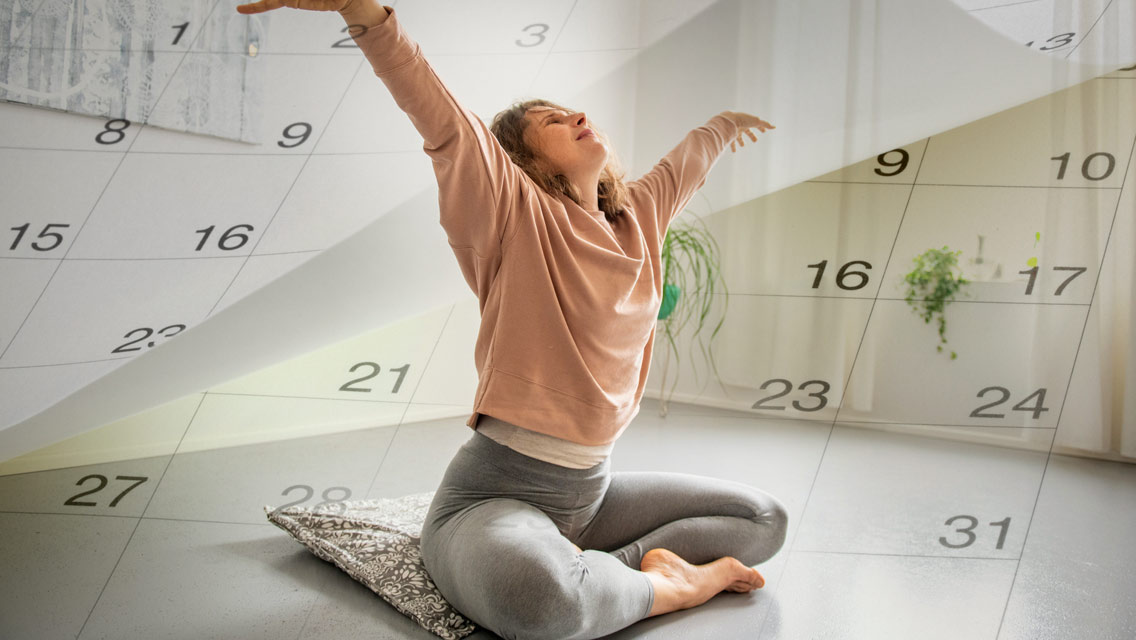Each phase of the menstrual cycle involves unique hormonal fluctuations that influence energy levels, perceived strength, and more. Cycle syncing your workouts can help you tailor your fitness training to these natural changes, allowing you to take advantage of high-energy, feeling-strong days while respecting low-stamina days.
Though cycle syncing is not required for improving your fitness, it is an opportunity to learn to listen to your body: Developing a deeper understanding of your hormonal patterns can potentially improve the experience, consistency, and efficacy of your workouts.
In other words, for some people, cycle syncing is an intuitive complement to intuitive training.
The following workout guide and recommendations are based on what you might experience in each phase. But remember that each body is unique. For instance, most cycles are 28 to 35 days, or four to five weeks, but your cycle length and the symptoms you experience may differ.
Figuring out what works best for you might take some trial and error. To that end, consider the following suggestions a jumping-off point. You can begin at any time in your cycle.
Here’s how to lean into your body’s changing energy levels to keep you moving through the four phases of your monthly cycle.
Menstruation
The first day of monthly bleeding, resulting from the uterus shedding its lining, marks day one of the menstrual cycle and the start of the follicular phase, the first half of your cycle leading up to ovulation. If you experience pelvic pain, a heavy flow, and ebbing energy — particularly common in the first day or two of your period — opt for low-impact, low-resistance movements, like walking, stretching and mobility, and lower-than-usual weight training.
As uncomfortable symptoms pass, your strength and energy may surge through the follicular phase. Up your cardio and weights as you feel comfortable and able.
| Cycle Phase | Details |
|---|---|
| Starts | Day one of period |
| Lasts | Three to seven days |
| Recommendation | Low-intensity workouts |
| Workouts to Try |
Follicular Phase
During this phase, your body is growing the egg that is ultimately released in ovulation. Estrogen levels are progressively rising, and you may feel really good, especially after the first day or two of menstruation. This can be an energized phase, so full-body workouts that get the heart rate up could be great.
| Cycle Phase | Details |
|---|---|
| Starts | Day one of period |
| Lasts | About 14 days, including menstruation |
| Recommendation | Moderate- to high-intensity workouts |
| Workouts to Try |
Ovulation
This phase is marked by the release of eggs from the ovary, which is triggered by shifts in estrogen, progesterone, and luteinizing hormone. Common symptoms in the day or two before and after ovulation include cramping, bloating, and sleep changes. You might be feeling good, but not as good as during the previous phase. Short (30 minutes or less) workouts of moderate intensity are a solid choice.
| Cycle Phase | Details |
|---|---|
| Starts | Generally around the midway point of your cycle |
| Lasts | About 24 hours, but symptoms may last for two to four days |
| Recommendation | Moderate-intensity workouts |
| Workouts to Try |
Luteal Phase
The latter half of the menstrual cycle is dominated by progesterone. It’s common to feel moody, bloated, crampy, and lacking in motivation. Moving your body can combat some of these symptoms. Just getting started may be especially challenging during this time.
Committing to something — even one minute of movement — can have a positive impact on its own. And there’s a chance that once you begin, it’ll be easier to keep going.
Stacking short workouts is a great choice during this phase. For those following a periodized strength-training program, this might be a good time to schedule a deload week. If you have a warm-up routine that you love, consider starting (and stopping) there.
| Cycle Phase | Details |
|---|---|
| Starts | After ovulation |
| Lasts | 12 to 14 days |
| Recommendation | Low- to moderate-intensity workouts |
| Workouts to Try |




